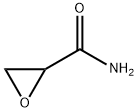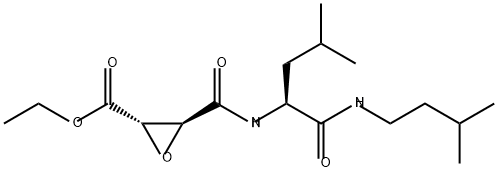GLYCIDAMIDE
Synonym(s):2,3-Epoxypropanamide;Oxiranecarboxamide
- CAS NO.:5694-00-8
- Empirical Formula: C3H5NO2
- Molecular Weight: 87.08
- MDL number: MFCD00468053
- EINECS: 227-163-2
- SAFETY DATA SHEET (SDS)
- Update Date: 2023-07-12 16:55:20

What is GLYCIDAMIDE?
Chemical properties
Light Orange Solid
The Uses of GLYCIDAMIDE
Glycidamide may be used as an analytical standard for the determination of the analyte in human and animal biological samples by various chromatography techniques.
The Uses of GLYCIDAMIDE
An epoxide metabolite of acrylamide. It is neurotoxic and carcinogenic
What are the applications of Application
Glycidamide is an epoxide metabolite of Acrylamide
General Description
Glycidamide, an active epoxide metabolite of acrylamide with potential biological activity, can be generated in vivo. Its mutagenic and genotoxic nature is well-known.
Safety Profile
Experimental reproductive effects. Human mutation data reported. When heated to decomposition it emits toxic vapors of NOx.
Properties of GLYCIDAMIDE
| Melting point: | 32-34°C |
| Boiling point: | 160.87°C (rough estimate) |
| Density | 1.2736 (rough estimate) |
| refractive index | 1.4940 (estimate) |
| storage temp. | 2-8°C |
| solubility | Chloroform (Sparingly), Ethyl Acetate (Slightly), Methanol (Slightly) |
| form | Solid |
| pka | 15.43±0.20(Predicted) |
| color | White to Pale Yellow Semi-Solid to |
| BRN | 227 163 2 |
| Stability: | Moisture Sensitive |
Safety information for GLYCIDAMIDE
| Signal word | Danger |
| Pictogram(s) |
 Exclamation Mark Irritant GHS07  Health Hazard GHS08 |
| GHS Hazard Statements |
H302:Acute toxicity,oral H315:Skin corrosion/irritation H317:Sensitisation, Skin H319:Serious eye damage/eye irritation H335:Specific target organ toxicity, single exposure;Respiratory tract irritation H350:Carcinogenicity |
| Precautionary Statement Codes |
P201:Obtain special instructions before use. P280:Wear protective gloves/protective clothing/eye protection/face protection. P302+P352:IF ON SKIN: wash with plenty of soap and water. P305+P351+P338:IF IN EYES: Rinse cautiously with water for several minutes. Remove contact lenses, if present and easy to do. Continuerinsing. P308+P313:IF exposed or concerned: Get medical advice/attention. |
Computed Descriptors for GLYCIDAMIDE
New Products
Tert-butyl bis(2-chloroethyl)carbamate (S)-3-Aminobutanenitrile hydrochloride N-Boc-D-alaninol N-BOC-D/L-ALANINOL N-octanoyl benzotriazole 4-Hydrazinobenzoic acid 3,4-Dibenzyloxybenzaldehyde Electrolytic Iron Powder 1,1’-CARBONYLDIIMIDAZOLE R-2-BENZYLOXY PROPIONIC ACID 4-HYDROXY BENZYL ALCOHOL 1,1’-CARBONYLDI (1,2-4 TRIAZOLE) S-2-CHLORO PROPIONIC ACID (2-Hydroxyphenyl)acetonitrile 4-Bromopyrazole 5-BROMO-2CYANO PYRIDINE 5,6-Dimethoxyindanone 5-broMo-2-chloro-N-cyclopentylpyriMidin-4-aMine 3-(Hydroxymethyl)benzoate N-Boc-2-chloroethylamine 1-Bromo-2-methoxy-3-nitrobenzene N-Methyl-3-cyclopenten-1-amine 2-Bromo-3-hydroxybenzaldehyde 1H-indazole-5-carboxamideRelated products of tetrahydrofuran


![2-(2-PYRIDYL)-3-[4-(TRIFLUOROMETHYL)PHENYL]OXIRANE-2-CARBOXAMIDE](https://img.chemicalbook.in/StructureFile/ChemBookStructure2/GIF/CB1782831.gif)




![2-(4-CHLOROPHENYL)-7-METHYL-5-PHENYL-1-OXA-5,6-DIAZASPIRO[2.4]HEPT-6-EN-4-ONE](https://img.chemicalbook.in/StructureFile/ChemBookStructure2/GIF/CB6215356.gif)
You may like
-
 Glycidamide CAS 5694-00-8View Details
Glycidamide CAS 5694-00-8View Details
5694-00-8 -
 7441-43-2 98%View Details
7441-43-2 98%View Details
7441-43-2 -
 1260741-78-3 6-Bromo-3-iodo-1-methyl-1H-indazole 98%View Details
1260741-78-3 6-Bromo-3-iodo-1-methyl-1H-indazole 98%View Details
1260741-78-3 -
 4-bromo-3,5-dimethylbenzenesulfonyl chloride 1581266-79-6 98%View Details
4-bromo-3,5-dimethylbenzenesulfonyl chloride 1581266-79-6 98%View Details
1581266-79-6 -
 2490430-37-8 98%View Details
2490430-37-8 98%View Details
2490430-37-8 -
 N-(5-Amino-2-methylphenyl)acetamide 5434-30-0 98%View Details
N-(5-Amino-2-methylphenyl)acetamide 5434-30-0 98%View Details
5434-30-0 -
 124371-59-1 98%View Details
124371-59-1 98%View Details
124371-59-1 -
 53857-52-2 98%View Details
53857-52-2 98%View Details
53857-52-2
Statement: All products displayed on this website are only used for non medical purposes such as industrial applications or scientific research, and cannot be used for clinical diagnosis or treatment of humans or animals. They are not medicinal or edible.